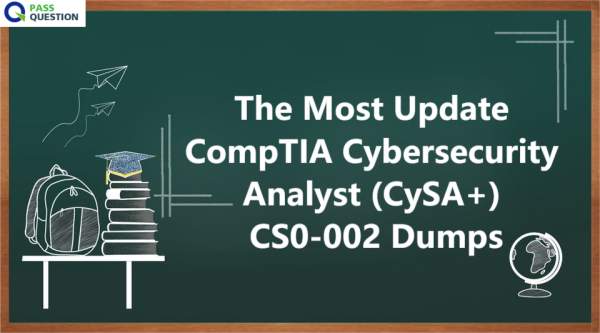The Most Update CompTIA Cybersecurity Analyst (CySA+) CS0-002 Dumps
CompTIA CySA+ CS0-002 is an intermediate-level Cybersecurity Analyst certification that entails the most recent security skills and trending job skills. The most update CompTIA Cybersecurity Analyst (CySA+) CS0-002 Dumps from PassQuestion can help you put aside your concerns about the actual exam. PassQuestion provides the highest quality CompTIA Cybersecurity Analyst (CySA+) CS0-002 Dumps that enable you to achieve the credentials in the very first attempt. It offers you the real exam simulation, which helps you to familiarize yourself with actual exam constraints, that's how your knowledge will be tested about the exam pattern. We assure you that CompTIA Cybersecurity Analyst (CySA+) CS0-002 Dumps will help you cover exam topics and acquire the required knowledge to pass the CompTIA CySA+ Certification exam.

CompTIA Cybersecurity Analyst (CySA+) CS0-002
The CompTIA CySA+ CS0-002 certification is for individuals who wish to validate their experience in Cybersecurity, and are willing to proactively protect and boost their organization's security. The CompTIA Cybersecurity Analyst (CySA+) certification verifies that successful candidates have the knowledge and skills required to leverage intelligence and threat detection techniques, analyze and interpret data, identify and address vulnerabilities, suggest preventative measures, and effectively respond to and recover from incidents.
Exam Information
Exam Codes: CS0-002
Number of Questions: Maximum of 85 questions
Type of Questions: Multiple choice and performance-based
Length of Test: 165 minutes
Passing Score: 750 (on a scale of 100-900)
Recommended Experience: Network+, Security+ or equivalent knowledge. Minimum of 4 years of hands-on information security or related experience.
Languages: English, Japanese, TBD - others
Retirement : TBD – Usually three years after launch
Testing Provider: Pearson VUE
Price: $381 USD
What Skills Will You Learn?
Threat and Vulnerability Management
Utilize and apply proactive threat intelligence to support organizational security and perform vulnerability management activities
Software and Systems Security
Apply security solutions for infrastructure management and explain software & hardware assurance best practices
Compliance and Assessment
Apply security concepts in support of organizational risk mitigation and understand the importance of frameworks, policies, procedures, and controls
Security Operations and Monitoring
Analyze data as part of continuous security monitoring activities and implement configuration changes to existing controls to improve security
Incident Response
Apply the appropriate incident response procedure, analyze potential indicators of compromise, and utilize basic digital forensics techniques
Check Update CompTIA CySA+ CS0-002 Quesrtions and Answers
1.An analyst is performing penetration testing and vulnerability assessment activities against a new vehicle automation platform.
Which of the following is MOST likely an attack vector that is being utilized as part of the testing and assessment?
A. FaaS
B. RTOS
C. SoC
D. GPS
E. CAN bus
Answer: E
2.An information security analyst observes anomalous behavior on the SCADA devices in a power plant. This behavior results in the industrial generators overheating and destabilizing the power supply.
Which of the following would BEST identify potential indicators of compromise?
A. Use Burp Suite to capture packets to the SCADA device's IP.
B. Use tcpdump to capture packets from the SCADA device IP.
C. Use Wireshark to capture packets between SCADA devices and the management system.
D. Use Nmap to capture packets from the management system to the SCADA devices.
Answer: C
3.Which of the following would MOST likely be included in the incident response procedure after a security breach of customer PII?
A. Human resources
B. Public relations
C. Marketing
D. Internal network operations center
Answer: B
4.An analyst is working with a network engineer to resolve a vulnerability that was found in a piece of legacy hardware, which is critical to the operation of the organization's production line. The legacy hardware does not have third-party support, and the OEM manufacturer of the controller is no longer in operation. The analyst documents the activities and verifies these actions prevent remote exploitation of the vulnerability.
Which of the following would be the MOST appropriate to remediate the controller?
A. Segment the network to constrain access to administrative interfaces.
B. Replace the equipment that has third-party support.
C. Remove the legacy hardware from the network.
D. Install an IDS on the network between the switch and the legacy equipment.
Answer: A
5.A small electronics company decides to use a contractor to assist with the development of a new FPGA-based device. Several of the development phases will occur off-site at the contractor's labs.
Which of the following is the main concern a security analyst should have with this arrangement?
A. Making multiple trips between development sites increases the chance of physical damage to the FPGAs.
B. Moving the FPGAs between development sites will lessen the time that is available for security testing.
C. Development phases occurring at multiple sites may produce change management issues.
D. FPGA applications are easily cloned, increasing the possibility of intellectual property theft.
Answer: D
6.A cybersecurity analyst is contributing to a team hunt on an organization's endpoints.
Which of the following should the analyst do FIRST?
A. Write detection logic.
B. Establish a hypothesis.
C. Profile the threat actors and activities.
D. Perform a process analysis.
Answer: C
7.A security analyst received a SIEM alert regarding high levels of memory consumption for a critical system. After several attempts to remediate the issue, the system went down. A root cause analysis revealed a bad actor forced the application to not reclaim memory. This caused the system to be depleted of resources.
Which of the following BEST describes this attack?
A. Injection attack
B. Memory corruption
C. Denial of service
D. Array attack
Answer: C
8.Which of the following software security best practices would prevent an attacker from being able to run arbitrary SQL commands within a web application? (Choose two.)
A. Parameterized queries
B. Session management
C. Input validation
D. Output encoding
E. Data protection
F. Authentication
Answer: A, C
- TOP 50 Exam Questions
-
Exam
All copyrights reserved 2025 PassQuestion NETWORK CO.,LIMITED. All Rights Reserved.

